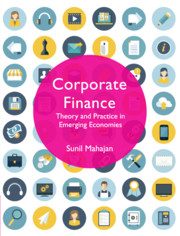Book contents
- Frontmatter
- Contents
- List of Figures
- List of Tables
- List of Corporate Snippets
- List of Abbreviations
- Preface
- Acknowledgements
- 1 Corporate Finance: A Conceptual Introduction
- 2 Financial Markets
- 3 The Time Value of Money
- 4 Capital Budgeting
- 5 Risk and Return
- 6 Valuation
- 7 Capital Structure and Financing
- 8 Dividend Payout: Policy and Practices
- 9 Leverage
- 10 Financial Derivatives
- 11 International Finance
- 12 Working Capital
- 13 Ratio Analysis
- Appendix
- Bibliography
- Index
4 - Capital Budgeting
Published online by Cambridge University Press: 30 April 2020
- Frontmatter
- Contents
- List of Figures
- List of Tables
- List of Corporate Snippets
- List of Abbreviations
- Preface
- Acknowledgements
- 1 Corporate Finance: A Conceptual Introduction
- 2 Financial Markets
- 3 The Time Value of Money
- 4 Capital Budgeting
- 5 Risk and Return
- 6 Valuation
- 7 Capital Structure and Financing
- 8 Dividend Payout: Policy and Practices
- 9 Leverage
- 10 Financial Derivatives
- 11 International Finance
- 12 Working Capital
- 13 Ratio Analysis
- Appendix
- Bibliography
- Index
Summary
Companies strive to grow by investing in projects. Growth is a key objective of any business and the only way to grow is to keep investing in projects. Identifying and selecting projects that add value to the firm is called capital budgeting. It refers to the decision and process of investing in long-term assets—buildings, plant and machinery, and intangibles such as brands and patents. As the name suggests, the company is budgeting for capital to be invested for long-term growth.
Investment in long-term projects is amongst the most critical decisions that a company takes. Capital investment is a high-value, high-impact decision which has the potential to significantly alter the fortunes of a company. When Nokia decided to invest in mobile telephones, using the Global system for mobile communication (GSM) technology, it was quite a change from paper products, footwear, tires and radio telephony that comprised the company's product portfolio at the time. The decision paved the way for its global dominance for two decades, from the mid-1990s to the 2000s. Recently, however, it was unable to correctly judge the shift in market preference to smartphones, and Nokia decided not to invest wholeheartedly in this space. The decision proved fatal and the company not only lost its leadership position but had to sell its mobile business to Microsoft Ltd in 2014.
Investment in long-term projects may fall under any of the following categories:
1. Expansion in existing capacities: a cement company increasing its capacity, from the existing 10 million to 15 million tons
2. Diversifying into new products: the Mahindra Group diversifying into real estate in the early years of the twenty-first century through Mahindra Lifespace Developers Ltd
3. Expanding to new markets/customers: an Indian bank going global and opening branches in the United Kingdom (UK), Maruti Ltd moving to the premium car segment and targeting a new set of customers
4. Acquisition: Kotak Mahindra Bank acquiring Vysya Bank for approximately ₹150 billion, Facebook's acquisition of WhatsApp for US$19 billion
5. Changes in the way business is run: installing an enterprise resource planning (ERP) System
6. Replacement of old machinery
7. Investing in research and development (R&D)
8. Others: pollution related, investing for regulatory compliance
- Type
- Chapter
- Information
- Corporate FinanceTheory and Practice in Emerging Economies, pp. 91 - 123Publisher: Cambridge University PressPrint publication year: 2020



